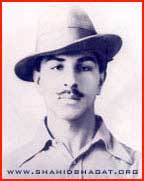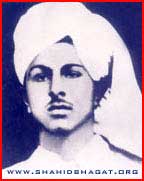|
| |
Biography: Shaheed Bhagat
Singh
Main
Article page |
Beauty articles
|
Health page |
Computers|
Diseases |
Education |
Entertainment |
Family
Business |Fitness|
Fruits and Vegetables
|
Jobs |
General |
Personality|
Technology
|
Tourism |
Useful Tips
Biography Page|
Heroes & Incredible peoples
|
Inventions

Bhagat Singh was one of the most prominent faces
of Indian freedom struggle. Bhagat Singh gave a new direction to the
revolutionary movement in India. He is often referred to as Shaheed Bhagat
Singh (the word shaheed meaning "martyr").
Bhagat Singh was born in a Sikh family in village Khatkar Kalan in Nawanshahar
district of Punjab. The district has now been renamed as Shaheed Bhagat Singh
Nagar in his memory. He was the third son of Sardar Kishan Singh and Vidyavati.
Bhagat Singh's family was actively involved in freedom struggle.
His father enrolled him in Dayanand Anglo Vedic High School, an Arya Samajist
school. At age 13, Singh began to follow Mahatma Gandhi's Non-Cooperation
Movement. At this point he had openly defied the British and had followed
Gandhi's wishes by burning his government-school books and any British-imported
clothing. Following Gandhi's withdrawal of the movement after the violent
murders of policemen by villagers from Chauri Chaura, Uttar Pradesh, Singh,
disgruntled with Gandhi's nonviolence action, joined the Young Revolutionary
Movement and began advocating a violent movement against the British.
In his teenage years, Bhagat Singh started studying at the National College in
Lahore,but ran away from home to escape early marriage, and became a member of
the organisation Naujawan Bharat Sabha ("Youth Society of India"). In the
Naujawan Bharat Sabha, Singh and his fellow revolutionaries grew popular amongst
the youth. It is believed that he went to Kanpur to attempt free Kakori train
robbery prisoners from the jail, but returned to Lahore for unknown reasons. On
the day of Dasara in October 1926, a bomb was blasted in Lahore, and Bhagat
Singh was arrested for his alleged involvement in this Dasara Bomb Case in 29
May 1927, and was released on a bail of Rs.60,000 after about five weeks of his
arrest.He wrote for and edited Urdu and Punjabi newspapers published from
Amritsar.
In 1919, w hen
Jalianwala Bagh massacre took place, Bhagat Singh was only 12 years old. The
massacre deeply disturbed him. On the next day of massacre Bhagat Singh went to
Jalianwala Bagh and collected soil from the spot and kept it as a memento for
the rest of his life. The massacre strengthened his resolve to drive British out
from India. hen
Jalianwala Bagh massacre took place, Bhagat Singh was only 12 years old. The
massacre deeply disturbed him. On the next day of massacre Bhagat Singh went to
Jalianwala Bagh and collected soil from the spot and kept it as a memento for
the rest of his life. The massacre strengthened his resolve to drive British out
from India.
On April 8, 1929 Bhagat Singh and Batukeshwar Dutt threw bombs in the Central
Assembly Hall while the Assembly was in session. The bombs did not hurt anyone.
After throwing the bombs, Bhagat Singh and Batukeshwar Dutt, deliberately
courted arrest by refusing to run away from the scene. During his trial, Bhagat
Singh refused to employ any defence counsel. In jail, he went on hunger strike
to protest the inhuman treatment of fellow-political prisoners by jail
authorities. On October 7, 1930 Bhagat Singh, Sukh Dev and Raj Guru were awarded
death sentence by a special tribunal. Despite great popular pressure and
numerous appeals by political leaders of India, Bhagat Singh and his associates
were hanged in the early hours of March 23, 1931.
His legacy prompted youths in India to begin fighting for Indian independence
and contributed to the rise of socialism in India.
| |
|




 hen
Jalianwala Bagh massacre took place, Bhagat Singh was only 12 years old. The
massacre deeply disturbed him. On the next day of massacre Bhagat Singh went to
Jalianwala Bagh and collected soil from the spot and kept it as a memento for
the rest of his life. The massacre strengthened his resolve to drive British out
from India.
hen
Jalianwala Bagh massacre took place, Bhagat Singh was only 12 years old. The
massacre deeply disturbed him. On the next day of massacre Bhagat Singh went to
Jalianwala Bagh and collected soil from the spot and kept it as a memento for
the rest of his life. The massacre strengthened his resolve to drive British out
from India.